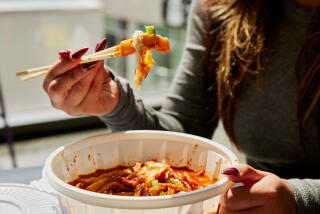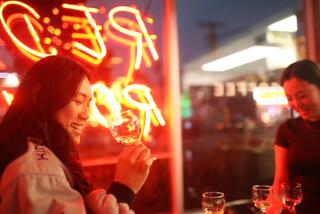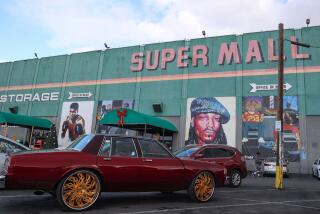Diary of a War of Attrition in Volatile Urban Dispute : Boycott: Business has plummeted in a store whose Korean-American owner killed a black man.
Early last month, a 42-year-old African-American man named Lee Arthur Mitchell entered Chung’s Liquor Market in South Los Angeles and attempted to purchase a wine cooler. The store owner’s wife refused to trade a piece of jewelry for partial payment.
According to police accounts, Mitchell then pretended to point a pistol and ordered the cash register emptied. Store owner Tae Sam Park produced a handgun, a struggle ensued and Mitchell was mortally wounded in the chest. Authorities concluded the shooting was justified.
The June 4 shooting has made the tiny store on Western Avenue a flash point in a volatile urban dispute, the latest in a series of violent episodes between Korean-American merchants who operate in South Los Angeles and their largely African-American clientele. The store has been the target of an ineffective Molotov cocktail attack and is picketed daily. Organizers say the boycott will not end until Park’s establishment is closed.
Times staff writer John H. Lee spent last Wednesday at Park’s store and filed this diary:
9:30 a.m.
In their dented 1981 Toyota Corolla, Tae Sam and Kum Ock Park pull into a dirt lot next to their liquor store. Chung’s Liquor Market (the name is owed to a previous owner) is situated near the intersection of Western Avenue and 79th Street, sharing space on the normally quiet block with two other liquor stores and a large African Methodist Episcopal church.
As she approaches the store, Kum Ock Park waves to police officers seated in a patrol car across the street and to a neighbor woman who has befriended her. Everyone else on the street is a stranger to her. She scoops up half a dozen copies of Korean-, Spanish- and English-language newspapers and waits for her husband to unlock three padlocks--one for a security gate, two for the door’s bolt and hasp.
“Every morning when I get up to go to work,” Tae Sam Park says in Korean after entering the store, “I wonder if we will finish the day without a tragedy.”
He begins this day by counting receipts from the day before--$19--scribbling the figure on the back of an old cigarette carton where a record of recent daily totals is being kept: on June 17, the first day of the boycott, $22; June 18--$46; June 19--$113; June 20--$27, and so on. Before the boycott, Park says, the store averaged more than $900 a day.
“We’re not staying open for the business,” he says. “There is no business.”
At 6 feet, 1 inch and 180 pounds, Park is taller and lankier than most Koreans. His wife says he has lost 15 pounds since the incident, in which he was struck once in the face and suffered three cracked ribs. Park says he has no desire to run up against the protesters. He believes the boycott leaders know their business, and might well succeed in closing him down. Still, for now, he’s staying.
“The fact is,” he says, “we didn’t do anything wrong, and we worked hard to get this far. If we walk away from this, they’ll find reasons to pick on more Korean markets. It won’t end with us.”
It’s 10 a.m., and time to open for business. Park, an infrequent smoker before the shooting, takes a drag on his third cigarette of the day. He drops a lighter to the floor in disgust.
His wife bends to retrieve the lighter and says brightly:
“ Jjah ! Let’s get the day started!”
Within five minutes, the first pickets arrive.
11:10 a.m.
An hour and a half goes by before the Parks see their first paying customer. Evelyn Smith, a 35-year-old African-American neighbor, has been shopping with the Parks for two years. She passes through a polite gauntlet of eight protesters. The pickets explain their cause and ask her to shop across the street at another market owned by Korean-Americans.
She heads into the shop anyway.
“I’m going to keep on buying,” Smith tells the pickets.
On her way out, Smith explains, “I don’t know about the incident you all are talking about, but I do know I’ve been treated good here, and I’m going to keep on coming as long as they be good to me.”
The demonstrators, angrier now, call out as she walks away.
“Wake up. Wake up,” says one.
“You’re sick,” says another.
11:30 a.m.
It’s turning out to be a hot day. Outside, a protester hauls out a large picnic cooler full of iced sodas--purchased from somewhere other than Park’s store.
Stan Esters, 38, an entertainment producer, identifies himself as a spokesman for the protesters (“a general captain”). He intervenes when protesters ride a store patron too hard.
“We want to keep down any kind of antagonism,” says Esters. “We don’t want anyone to feel threatened by our presence.”
Boycott organizers say the shooting illustrates gravely the misunderstandings that can occur when African-Americans shop at neighborhood businesses not owned by blacks.
Danny Bakewell, director of the Brotherhood Crusade organization, describes the boycott as part of a campaign to target businesses where merchants are disrespectful and don’t give back to the neighborhood in the form of jobs or community investment.
The boycott will continue, organizers say, until the store is closed or the shooting investigation is reopened.
Esters says Mitchell, a close friend, was incapable of committing the violent and ill-planned crime that allegedly led to his death.
“I just can’t see it,” Esters said. “I knew Arthur for 20 years, and for him to do something like that would have been totally out of character. He knew not to be messing with people down here. . . . He knew doggone well, a Korean liquor store’s going to have a weapon in it.”
1:10 p.m.
Joseph M. Cho, the territory manager from Southern Wine and Spirits Co., arrives to collect the Parks’ monthly bill--$1,704.40. They don’t have the money to cover it. Cho tells them they have 12 days to pay before a late fee is imposed.
It’s another indicator of the boycott’s effectiveness. An official at Mid City Bank, which is administering the Parks’ $120,000 Small Business Administration loan, had called earlier when he saw a news report on the boycott. Park says the bank had scheduled a meeting with him.
“They want to knowif I can keep paying off the loan,” he says.
He doesn’t know.
Park wanted--and says he still wants--to sell the store. Park estimates $349,000 was the pre-boycott value of the business. That figure seems unattainable now, and Park fears that if he is forced to close, the store will sell for even less.
2 p.m.
The owner of a nearby liquor store stops by to check on the protest. She identifies herself only as “Mrs. Go” of K&W; Deli Liquor Store. Late one May night, two of her Korean-American workers were shot and killed. The attacker, described by police as African-American, has not been caught.
Park tells Mrs. Go that, after reading about the shootings, he decided to shorten his hours.
Throughout the day, workers from five other Korean-American liquor stores will visit the Parks to lend support. Strangers, they hail from shops on 35th Street and Central Avenue, 90th Street and Vermont Avenue, Century Boulevard and Normandie Avenue, and as far away as Paramount Boulevard in Long Beach.
They scan the rows of shelving which, Kum Ock Park boasts, were constructed by her husband. They take note of the merchandise: over-the-counter drugs, four flavors of Bubblicious Bubblegum, candles with Spanish biblical passages, and pornographic magazines with sheets of white paper taped to conceal the covers.
The uncanny jumble is familiar to them. The store is typical. Park is typical. As they take it all in, the grocers’ faces seem to say, “Thank God this isn’t happening to me.”
2:20 p.m.
Park sits behind the counter in a bucket seat retrieved from an abandoned car on the dirt lot next door. Park is engrossed in a new Korean telephone directory, studying the business listings, considering his options.
“We’ve had enough of the liquor store business,” he says. It’s not just the boycott ordeal. It’s also the hours. “I’m tired of working Sundays. . . . Actually, I’m just plain tired.”
The conversation shifts from frustrated diatribes, to the mundane banter of running a family business, to the recounting of the “sacon,” the incident. Park estimates he has gone through the shooting details about 50 times, with police, relatives and friends. He says it never leaves him: the robbery, the struggle, the gun’s “clicking sound” after the last shot was fired.
Tedium sets in. There is little need for reordering or restocking, for tidying displays. Park naps momentarily in the old auto seat, telephone directory spread across his lap.
3:30 p.m.
Shouts from outside shatter the afternoon lull.
“Don’t go in there! Don’t go in there! Don’t go in there!”
Park rubs his temples, and doesn’t bother to look for a would-be customer.
“It’s a psychological game they play,” he says in a low voice. “No one is coming, but they shout like that to get our hopes up.”
Throughout the day, protesters solicit support from passersby.
The sound of car horns, sporadic at first, grows steadily louder as homebound traffic picks up.
HONK FOR JUSTICE, a picket sign instructs.
5 p.m.
A young African-American man wearing a shower cap strides into the store, turns quickly, and curses at the protesters. He tells store helper Sun Lee to retrieve a cold, 40-ounce bottle of Rainier Ale from the refrigerator. The young man asks the price of a package of disposable diapers and asks that two cans of baby formula be brought to the front.
Kum Ock Park rings up the items on the cash register --$9.78.
“Next time you want to sell this (merchandise),” the young man says, his voice low and deliberate, his speech punctuated with obscenities, “think about the (person) you killed.”
He names a street gang, flashes a gang sign and saunters outside--the items still on the counter. The Korean-American store workers are left wondering.
Esters pokes his head into the store.
“I don’t know what that little guy did in here,” the protest captain says, “but he is not a part of our group.”
8 p.m.
It’s growing dark. The Parks hurry to close. A cursory review of the day’s business shows that, between African-American and Latino customers, total receipts came to $24. Korean-Americans spent $53.
Park swallows his third dose of Extra-Strength Tylenol, sets the alarm, fastens the three padlocks and heads quickly with his wife to the car. In 30 minutes, they’ll be home.
The protesters, too, seem eager to call it a day.
A boy about 4 years old is the only one among the pickets to take notice as the Parks back into an alley and pull away.
“They locked it up!” he sings out.
The boy wears orange shorts, a navy blue ski jacket and tiny Air Jordan sneakers. He is dwarfed by his picket sign and, by the bitterness of its message: “GET OUT OF OUR COMMUNITY.”
More to Read
Sign up for Essential California
The most important California stories and recommendations in your inbox every morning.
You may occasionally receive promotional content from the Los Angeles Times.










